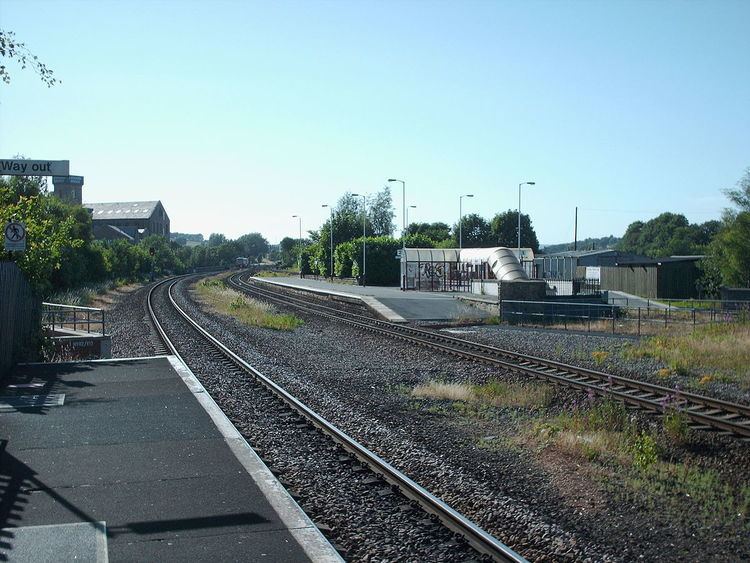Station code MIR DfT category F1 Number of platforms 3 | Grid reference SE203195 Managed by Northern 2011/12 0.334 million | |
 | ||
Similar | ||
Mirfield railway station west yorkshire england 16th july 2016
Mirfield railway station serves the town of Mirfield in West Yorkshire, England. It lies on the Huddersfield Line managed by Northern but also now served by Grand Central Railway and is 4 miles (6 km) north east from Huddersfield.
Contents
- Mirfield railway station west yorkshire england 16th july 2016
- 29 steps too far mirfield railway station 2016
- History
- Facilities
- Northern
- Grand Central West Riding
- References
The platforms have an unusual configuration. Platforms 1 and 2 form an island platform on the western side of the bridge over Station Road/Hopton New Road. Trains from Platform 1 go to Leeds and Wakefield Westgate (eastbound); Platform 2 is rarely used for normal scheduled services but is passed by non-stopping westbound trains to Huddersfield. Platform 3 is a side platform on the eastern side of the bridge; trains are towards Huddersfield, Halifax, Bradford Interchange and Brighouse (westbound). The train to Leeds takes around 25 minutes and to reach Huddersfield takes around 10 minutes.
29 steps too far mirfield railway station 2016
History
The town received its first railway in 1840, when the Manchester and Leeds Railway opened the first section of its cross-Pennine main line between Normanton and Hebden Bridge (completing it through to Manchester on 1 March 1841). It did not actually get a station though until April 1845, when the company opened one shortly before submitting plans to Parliament to build a branch line from the town along the Spen Valley to Bradford via Cleckheaton. Approval was granted for the route the following year and it was opened as far as Low Moor on 12 July 1848 and through to Bradford two years later. By this time further lines had been opened from nearby Heaton Lodge Junction to Huddersfield by the Huddersfield & Manchester Railway (opened on 3 August 1847) and from Thornhill to Leeds by the Leeds, Dewsbury & Manchester Railway (opened 18 September 1848). The LNWR (which had absorbed both the H&M and LD&M by 1849) had originally planned to build its own route through Mirfield, but after negotiations with the Lancashire and Yorkshire Railway (successors to the M&L) agreed to not to go ahead in return for the granting of running powers over the Thornhill to Heaton Lodge section (and also allowing the L&Y access to Huddersfield). This meant that the railway passing through the town soon became extremely congested, carrying as it did the traffic on two main trunk routes between Manchester and Leeds (the Huddersfield & Manchester company having completed its route through Stalybridge in August 1849) and it led to the station gaining a notorious reputation for delays. This persisted even after the Heaton Lodge - Thornhill section was quadrupled in 1884, and it was not until the LNWR opened an alternative Huddersfield to Leeds route at the turn of the century that the situation began to improve. To facilitate interchange, a new station was built 202 yd (185 m) to the east of the original; the contract for the station (excluding roof) was placed on 25 May 1864, the roof contract being placed on 26 April 1865. The new station centred on a large island platform with overall roof, and facilities included a hotel, buffet and billiard room; it opened on 5 March 1866.
Today the station remains busy, despite the loss of the Spen Valley service to Bradford from 14 June 1965 and the links to Normanton and York on 5 January 1970 (the line via Brighouse also closed at the same time, but this reopened in 2000 for peak hour services). It has also lost its buildings to demolition (in the mid-1980s) and one of its four tracks but gained the aforementioned third platform as part of a set of capacity improvements in the late 1980s.
Facilities
The station is unstaffed and has no ticketing facilities of any kind - these instead must be bought in advance or on the train. Digital display screens, timetable posters and automated announcements provide train running information. Shelters are provided on each platform, but only platform 3 has step-free access (from the station car park). Access to the older island platform is via a subway with stairs up to platform level.
Northern
Eastbound from Mirfield, two trains per hour (approximately half-hourly) operate on weekdays and Saturdays towards Leeds, with an hourly service to Wakefield Westgate via Wakefield Kirkgate.
Westbound two trains an hour serve Huddersfield, with connecting services at Huddersfield to Bradford Interchange, Penistone, Manchester Piccadilly and Manchester Airport. There is also an hourly daytime service to Manchester Victoria via Brighouse and Hebden Bridge - this was introduced as part of the December 2008 timetable alterations on the Calder Valley Line. During the weekday morning peak an additional train runs to Leeds.
On Sundays, a two-hourly service operates to Leeds and Huddersfield. There are no Sunday services to Wakefield or Hebden Bridge/Manchester.
Grand Central - West Riding
The station now sees a number of direct services to London Kings Cross via Wakefield Kirkgate, Pontefract and Doncaster, which commenced on 23 May 2010. In January 2009, Grand Central Railway have had their application for train paths to run a Bradford Interchange (via Halifax and Brighouse) to London service accepted by the Office of Rail Regulation. In the December 2015 timetable, four trains call in each direction throughout the week (including Sundays).
